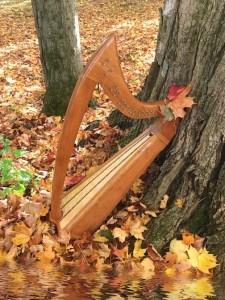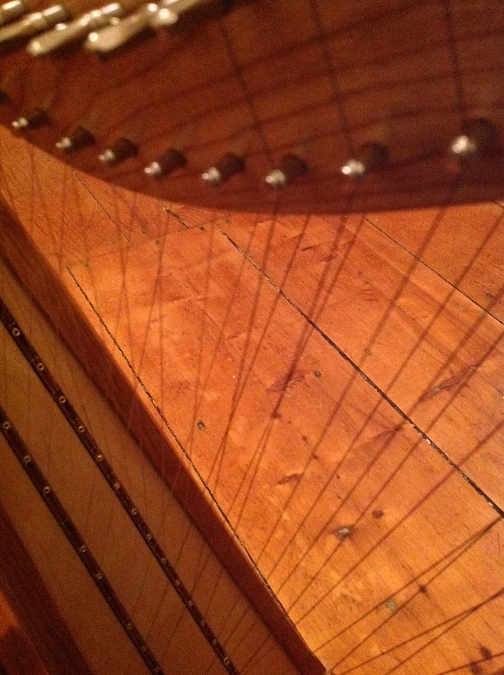Since my double strung harp is out of commission for the time being, I’ve been relying on my lightweight (10 lbs.!) Esabelle harp to come to church with me every Sunday.
Playing her on a weekly basis has certainly helped improved my technique! Cross-strung (X) harps are usually not wire; they normally have nylon strings instead and therefore don’t call for the usual wire harp playing techniques: nails, damping, etc. But nylon and wire X harps both share similar playing methods: the fingers of one hand reaches up for chromatic notes while the fingers on the opposite hand goes downward for the same sharps and flats. This is due to the angle of the chromatic rank of strings as it passes across diatonic string rank. Looking at the strings from the player’s point of view above the neck, one sees an X.
On a nylon strung cross harp, learning this geometry is challenging enough. Add in the long-ringing resonance of wire strings that occasionally need damping, and the repertoire of basic playing technique for this instrument grows!
However, it’s not impossible. Play the cross wire harp as you normally would, but also using your nails as on a traditional wire harp. In the beginning, as you’re learning, you will naturally play at a much slower speed. You may find you have to consciously start thinking about damping strings with your finger pads, which is often times an automatic action after years of playing wire-strung harp.
As one finger(nail) goes up to pluck, the previously played note, especially if it’s an interval of a second above or below, can be damped by the thumb pad simultaneously going down to damp. Or vice versa, depending on which hand is playing. Intervals of seconds, like C sharp and B, can be a little jarring on a wire harp in a way that they maybe aren’t on other instruments. At least that’s been my experience, so I have a tendency to damp them in favor of more consonant intervals, like thirds and fifths, that support the natural harmony of the bell-like wire sound.
(But please note that they don’t really sound like actual cast bells; carillonneur husband George Matthew Jr. has made that clear to me. There’s no minor third in ringing wire harp wires as there is in real carillon bells! Harp wires tend to have a fundamental and a strong octave overtone though.)
Getting used to playing a wire X harp takes some time. I started by focusing on two keys: F Major, which uses the Bb string and G Major, which uses the F# string. Learning to hit those angled chromatic strings instead of the natural B and F is a good workout for your brain and your ears will certainly tell you when you’ve plucked the wrong one!
My learning strategy started with playing those two scales and breaking it down even further: just play A Bb C and notice how different it looks and feels from playing A B C.
Or try playing F# F back and forth and note the string spacing before going back to playing E F# G. Then try playing the entire scale.
After getting comfortable with the placement of the chromatic notes, then you can try playing a very simple melody.
I usually don’t play chords on Esabelle very much. Her individual strings are very harmonically rich in overtones and trying to play chords just sounds overwhelming and I lose the sense of what’s going on in the underlying melody. I’ve found though, that she makes for a very good contrapuntal instrument. I’ve started exploring Bach’s organ music transcribed for lever harp and found she is an excellent harp for that! Baroque harpsichord music is another possibility.
Esabelle’s range is quite modest, being a lap harp: G to G 22 strings, so it took me a while to find some nice Bach arrangements that would work well on her. Eventually I plan to play these on my double wire Argent Fox harp, which has a larger range. But she is also excellent for playing a variety of international and little-known Advent/Christmas carols for the upcoming season!



